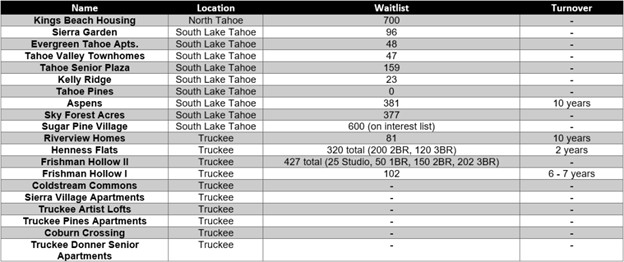Housing 101: 700 on the Waitlist – Tahoe’s Affordable Housing Reality
June 18, 2025
The complexities surrounding affordable housing often lead to confusion. Terms like workforce, achievable, and affordable housing are used interchangeably, yet each describes a critical part of the region’s housing challenges. At its core, affordable housing simply means having enough homes at prices accessible to all community members, regardless of income.
Mountain Housing Council, a program of the Tahoe Truckee Community Foundation, has been working since 2017 to identify and define who in our community needs housing, if and what the barriers are to affordability, and how our region can address the problem. Their research consistently reveals significant unmet housing needs. The latest report from 2023 identifies a startling gap—approximately 8,200 housing units are urgently required across various income levels, family sizes, and housing types. These comprehensive reports provided the first real data on the range of unmet housing needs in our region and spurred urgent discussion and action within our communities. The work we do at the Tahoe Housing Hub is a direct result of the groundwork laid by the Mountain Housing Council.
For many residents, these numbers seem abstract. However, a recent Tahoe Daily Tribune article vividly illustrates the depth of this crisis through real-world implications. It reports that nearly 700 people are currently on waitlists for the limited number of available affordable housing units—homes specifically priced for those earning 80% or less of the area median income (AMI). The article further notes infrequent turnover, highlighting how rarely new opportunities become available.
It’s natural to question, “Do we really need more affordable units in Tahoe?” Yet, the waitlist data provides a clear and direct indication that the demand is very real. Addressing this critical housing shortage is fundamental for maintaining the strength and stability of our community.
The Tahoe Housing Hub continues working actively to address these housing needs, advocating for solutions while helping to increase the number of affordable units available to residents through the ADU Accelerator program. This important work is part of a broader collaborative effort across the region involving partners such as Placer County, Town of Truckee, Truckee Tahoe Workforce Housing Agency (TTWHA), and the Mountain Housing Council (MHC), among others. Together, these groups demonstrate a regional commitment to resolving our housing challenges.

*Housing Chart Source: Tahoe Daily Tribune. The City of South Lake Tahoe requires property managers to keep track of turnover and wait lists. The data is not available for many of the properties located in Truckee.